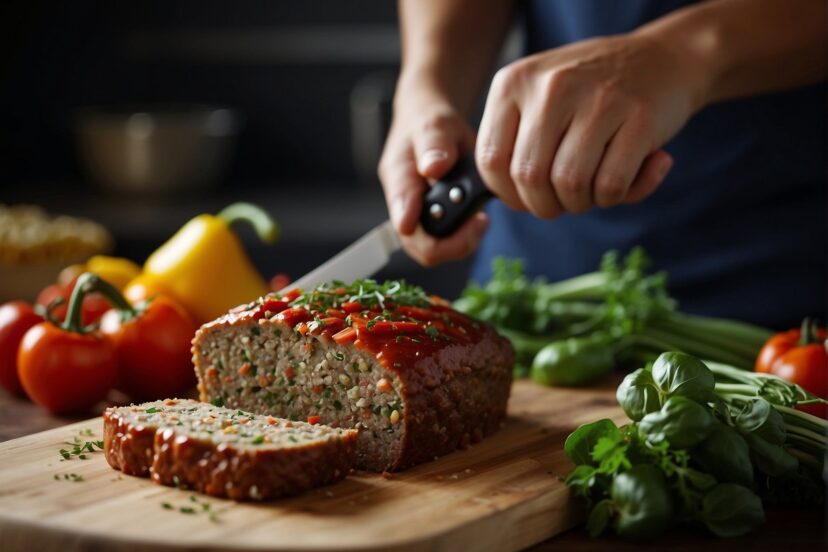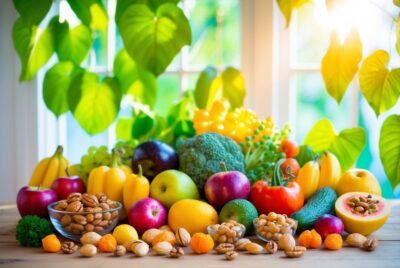Vegetarian Meatloaf: A Flavorful Journey
*We may earn a commission for purchases made using our links. Please see our disclosure to learn more.
Vegetarian Meatloaf: A Flavorful Journey into Meat-Free Comfort Food
Vegetarian meatloaf reimagines a classic comfort food for those who follow a plant-based diet or look to reduce their meat consumption. Crafting a scrumptious meatloaf without the meat may sound challenging, but with a variety of ingredients at our disposal, it is not only possible but can also yield a dish that’s rich in flavor and satisfying in texture. My experiments with ingredients like mushrooms, lentils, and plant-based meat substitutes have shown they can mimic the umami depth and hearty bite of the traditional meatloaf.

In my kitchen, I’ve found that the key to a great vegetarian meatloaf lies in nailing the combination of ingredients which bind well and create a loaf that holds together during cooking. Through trial and error, I’ve learned to appreciate the role of each element, from onions and garlic adding aroma to spices that bring warmth and depth. It’s not simply about creating a meat-free alternative but offering a standalone dish that deserves its own spot on the dining table.
The process of making a vegetarian meatloaf also affords a canvas for creativity. I often use a glaze, borrowing from the classic meatloaf recipes, to add a tangy-sweet finish to the loaf. It caramelizes beautifully in the oven, creating a delectable crust that contrasts with the moist interior. By bringing these elements together, the vegetarian meatloaf emerges not just as a substitute, but as a dish with its own merit, capable of winning over even dedicated meat-eaters.
The Basics of Vegetarian Meatloaf

Creating a vegetarian meatloaf that rivals its meat-based counterpart requires understanding meat substitutes and ensuring that the key ingredients contribute the right flavor and texture. I will guide you through using various plant-based ingredients to achieve that desired savory loaf experience.
Understanding Meat Substitutes
When preparing a vegetarian meatloaf, it’s crucial to select a suitable meat substitute that is rich in protein and fiber. Plant-based ground meats from brands like Beyond Meat or Impossible Foods are popular choices because of their meat-like texture and ability to bind the other ingredients. For a more whole-food approach, lentils, black beans, or chickpeas can be processed and used as a base. These not only provide the necessary substance and protein to mimic the density of meatloaf but are also high in fiber.
Key Ingredients for Flavor and Texture
To achieve the signature flavor and texture of traditional meatloaf, I focus on a strategic combination of ingredients:
- Breadcrumbs: These are essential for the structure of the loaf, giving it the right firmness without being too dense.
- Eggs: I usually incorporate eggs as a binding agent. However, for a vegan version, flaxseed or chia seed mixtures can be used as effective alternatives.
For flavor, a blend of aromatic vegetables like onions and garlic, along with herbs such as thyme, marjoram, and sage, bring each bite to life with depth and savoriness. In terms of equipment, a 9 × 5-inch loaf pan sets the classic shape, and I prefer to line it with parchment paper for easy removal.
In summary, choosing the right meat substitute is foundational, while incorporating flavor-imparting ingredients and ensuring the texture mimics that of traditional meatloaf will result in a successful vegetarian dish.
Preparation Steps

Before I dive into the specifics, I want to stress the importance of precision and attention to detail during the preparation phase. Properly mixing the ingredients, shaping the loaf, and adhering to baking guidelines are essential for a delicious vegetarian meatloaf.
Mixing Ingredients
To begin, I heat my skillet with a little oil to sauté onions and garlic until they’re translucent, which typically takes about three minutes. In a food processor, I combine the sautéed vegetables with the other main ingredients, like beans, lentils, or meatless crumbles, and seasonings. Here’s my brief breakdown:
- Sauté: Onions and garlic until translucent.
- Process: Mix sautéed veggies with main ingredients in a food processor until well combined.
- Season: Add herbs and spices as desired.
Shaping the Loaf
After the ingredients are thoroughly mixed, I take the mixture and shape it into a loaf on a baking tray lined with parchment paper. This is my preferred method for a consistent shape and easy removal after baking. My approach is straightforward:
- Transfer: Move the mixed ingredients to a parchment-lined tray.
- Shape: Mould the mixture into a loaf shape.
Baking Guidelines
I preheat my oven, ensuring it’s at the right temperature (usually around 375º F). I place the shaped loaf in the center of the oven and bake it until the meatloaf is firm and has a golden-brown crust. Here’s what I keep an eye on:
- Temperature: Preheat oven to the recipe’s specified temperature.
- Placement: Position loaf in the center of the oven.
- Duration: Bake until firm and golden-brown (timing varies by recipe).
The key is to monitor the meatloaf as it bakes to avoid overcooking or undercooking, which impacts texture and taste.
Vegetarian Meatloaf Recipes

I find that comfort food can be both hearty and meat-free, and vegetarian meatloaf recipes are a testament to this belief. These loaves are packed with flavor, providing a satisfying main dish that caters to various tastes and dietary restrictions.
Classic American Loaf
In my classic American vegetarian meatloaf, the key is to use a base of well-cooked lentils and sautéed vegetables. I ensure onions, garlic, and mushrooms are cooked until golden before combining them with mashed lentils and other ingredients. This mix is then shaped into a loaf and baked to achieve a firm, sliceable consistency.
Ingredients:
- Lentils: 1 cup
- Olive oil: 2 tbsp
- Onion (diced): 1 medium
- Garlic (minced): 2 cloves
- Mushrooms (chopped): 1/2 pound
- Marjoram: 1 tsp
- Thyme: 1 tsp
- Sage: 1 tsp
- Bread crumbs or oats: for binding
- Salt and pepper: to taste
Instructions:
- Preheat oven to 375°F (190°C).
- Prepare lentils and sauté vegetables as described, then combine in a bowl with breadcrumbs or oats for binding.
- Season with salt, pepper, and additional herbs if desired.
- Press mixture into a greased loaf pan and bake for roughly 45 minutes.
Italian-Infused Meatless Loaf
My Italian-infused version includes a generous blend of classic Italian herbs and the addition of sun-dried tomatoes and a balsamic glaze for that extra depth of flavor. It strives to bring a twist to the traditional loaf, incorporating the bold and robust flavors of Italy.
Ingredients:
- Sun-dried tomatoes: 1/2 cup, chopped
- Italian seasoning: 2 tsp
- Balsamic glaze: 1 tbsp
- Vegan cheese (optional): 1/2 cup shredded
- Fresh basil: a small bunch, chopped
Instructions:
- Prepare and mix the base ingredients similar to the classic loaf, including Italian seasoning.
- Add in sun-dried tomatoes, vegan cheese, and fresh basil.
- Form mixture into a loaf shape, top with balsamic glaze, and bake as per the classic loaf instructions.
Alternative Ingredients for Special Diets
I understand the importance of catering to special diets, therefore my vegetarian meatloaf can easily be adapted for gluten-free and vegan preferences. By substituting bread crumbs with gluten-free oats or a gluten-free bread crumb alternative, the recipe can accommodate those avoiding gluten. Similarly, flax eggs or chia eggs can replace traditional eggs for a vegan-friendly loaf.
Gluten-Free Option:
- Use gluten-free oats or bread crumbs instead of regular bread crumbs.
Vegan Meatloaf Option:
- Replace eggs with flax or chia eggs (1 tbsp ground flaxseed or chia seeds mixed with 3 tbsp of water equals one egg).
- Omit cheese or use dairy-free cheese alternatives.
When adapting recipes, ensure all condiments and seasonings used are in line with the specific dietary requirements.
Customizing Your Loaf

Crafting the perfect vegetarian meatloaf allows me to think outside the traditional culinary box. I use various spices, herbs, and crunchy additions like nuts and seeds to create a loaf that’s both flavorful and unique in texture. Let’s explore how these elements can elevate the humble meatloaf to a gourmet level.
Experimenting with Spices and Herbs
Spices and herbs are my secret weapons when it comes to maximizing flavor. Italian seasoning is a fail-safe choice, offering a rich and savory flavor profile that complements the vegetarian base beautifully. However, I don’t stop there. I often play with individual spices such as marjoram, thyme, and sage, adding them in teaspoon increments to achieve a well-balanced taste. Here’s a simple guide I follow:
- Marjoram: adds a slightly sweet and citrusy flavor.
- Thyme: imparts a subtle, earthy tone.
- Sage: offers a robust, peppery essence.
When it comes to herbs, freshness is key. I use fresh herbs when available, finely chopping them to distribute their flavors evenly. I might even sprinkle some extra on top before serving for a visual and flavorful garnish.
Adding Nuts and Seeds for Extra Crunch
I find that texture plays a significant role in the eating experience, which is why I incorporate nuts and seeds into my vegetarian meatloaf. Walnuts are my top choice due to their meaty texture and ability to absorb flavors. I toast them lightly to enhance their crunchiness before adding them to the mix. Here is a quick list of nuts and seeds I use:
- Walnuts: for a hearty, meat-like texture.
- Sunflower seeds: for a subtle crunch.
It’s essential to chop the nuts to the desired size before mixing them into the loaf to ensure they integrate well without overwhelming the other ingredients. To avoid a loaf that’s too crumbly, I balance the dry ingredients with the wet components of my recipe to maintain the right moisture content.
By being thoughtful with my choice of spices, herbs, nuts, and seeds, I craft a vegetarian meatloaf that is both satisfying and packed with savory flavors and delightful textures.
Serving and Storing

In my experience, ensuring that your vegetarian meatloaf remains delightful from the first serving to the last is all about proper serving and storing techniques.
Ideal Side Dishes
When I serve vegetarian meatloaf as the main dish for dinner, I prefer accompanying it with sides that complement its rich, savory flavors. Here are my top picks:
- Carrots: Glazed or roasted carrots offer a sweet contrast.
- Mashed Potatoes: Creamy mashed potatoes are a classic pairing.
- Green Beans: Almondine or simply steamed, they bring a fresh crispness.
These sides not only balance the meal but also enhance the overall dining experience with varied textures and flavors.
Tips for Reheating and Freezing
Storing leftovers properly maintains the quality of your meatloaf. Here’s how I handle it:
- Refrigerating: Wrap the meatloaf tightly in plastic wrap or store in an airtight container. It should last up to three days.
- Freezing: For longer storage, I wrap the meatloaf in foil, then place it in a freezer bag, squeezing out as much air as possible before sealing.
When it’s time to reheat, I have found the following methods to be effective:
- Oven Reheating: Preheat the oven to 350°F. Place the meatloaf on a baking sheet and cover with foil. Heat for 25-30 minutes, or until it’s thoroughly warmed.
- Microwave: For a quicker option, I slice the meatloaf and microwave it on high for 1-2 minutes. I always cover it to avoid drying out.
Remember, if it’s coated with sauce, you might want to add a little extra on top to keep it moist during reheating.
Frequently Asked Questions
In addressing some of the most common inquiries about vegetarian meatloaf, I aim to provide clear, concise solutions that will enhance your meatless cooking experience.
1. How can I make a vegetarian meatloaf that doesn’t fall apart?
To ensure your vegetarian meatloaf maintains its structure, I find it effective to use binders such as breadcrumbs, oats, or flaxseed meal. Additionally, allowing the loaf to rest before slicing helps it solidify.
2. Which ingredients are commonly used in making a vegetarian meatloaf?
Common ingredients for vegetarian meatloaf include legumes like chickpeas or lentils, nuts, various vegetables like onions and garlic, seasoning, and a binding agent such as bread crumbs or oats to hold the loaf together.
3. What are some easy vegetarian meatloaf recipes for beginners?
For beginners, straightforward recipes involving a mix of ground vegetables, grains like quinoa, and binding agents such as eggs or egg replacements can simplify the process. Seasoning can be adjusted according to taste.
4. How can I incorporate mushrooms into my vegetarian meatloaf?
Mushrooms can be finely chopped and sautéed until golden before being added to the meatloaf mix. They contribute a rich, umami flavor and an additional layer of texture that complements the other ingredients.
5. Can Beyond Meat be used to make a vegetarian meatloaf, and if so, how?
Yes, Beyond Meat can be used as a substitute for ground meat in vegetarian meatloaf recipes. It can be seasoned and mixed with other meatloaf ingredients, then baked to create a dish that mimics the texture and taste of traditional meatloaf.




